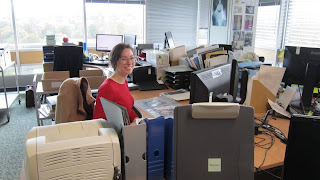This week, it's Archivist Louise taking a turn on the blog:
This past month has been an extremely hectic one for me in terms of outreach - I've given four talks in three weeks, for example, each one focusing on a different aspect of our work here at LHSA, and yesterday I was out and about at the Royal College of Psychiatrists History of Psychiatry Special Interest Group meeting in Glasgow telling researchers about our extensive collections on Lothian asylums and psychiatric care.
Our collections from and related to the
Royal Edinburgh Hospital certainly are popular with students, academics and genealogists: rarely a week goes by when part of the collection isn't being used in a family history enquiry, or being viewed in the reading room. We do hold fascinating records from other Lothian asylums, though (including an extensive one for
the Borders), which also are more than worthy of investigating. So for this week's blog - since one of my recent talks was on the history of East Lothian hospitals - I thought that I would focus on an East Lothian psychiatric institution: Herdmanflat Hospital, once Haddington District Asylum.
More recently a psychiatric hospital serving the whole of East Lothian, Herdmanflat has had a long
history, reflected in the archives we hold....
 |
| Herdmanflat Hospital, LHSA photographic collection |
From reports of the General Board of Control (the committee which
inspected all asylums in Scotland from 1857), we know that the hospital opened in November 1866 as Haddington District Asylum on the site of a farm called Herdmanflat. It housed just nine patients then –
five male and four female – growing to around 70 the next year, and 138 by 1900.
In 1867, the report of the General Board of Control stated that: ‘The aspect of all gives
indications of abundant diet, good management, and constant attention to
cleanliness, tidiness and comfort.’ and the inspectors were very happy that
‘each patient is bathed once a fortnight.’ As a district asylum, it served mostly paupers. The report goes on to mention that patients
were kept busy: women in sewing, knitting, cleaning or laundry work, men in the
gardens, stable and grounds.
People often imagine the Victorian asylum as a grim place –
a Bedlam type institution with little joy. Our records from psychiatric
hospitals have evidence to dispel this, though – in Haddington District Asylum,
we know there were evening amusements, dancing, public readings, a library,
exercise within and outside the grounds, and even excursions. Herdmanflat was brought into the NHS in 1948, managed by
different local boards until it came under the larger umbrella of Lothian
Health Board in 1974 (the predecessor to NHS Lothian)
So what
records do we hold for Herdmanflat? We do have some administrative records,
like this 1869 booklet of rules and regulations...
 |
| Haddingtonshire District Lunatic Asylum: Rules and Regulations, 1869 (LHB47) |
But we
have most records from Herdmanflat for its patients, in the form of registers, admission papers
and cases. These span 1866 to 1993 in all, with some types of records being better represented
than others. One of the most interesting groups of records for genealogists, though, are the patient case books that we hold, which record each patient
admitted to the hospital from 1866 to 1915. Here’s one for Alexander Tulloch, for example:
 |
| Casebook entry: Alexander Tulloch, 1890 (LHB47/1) |
Aged just 34
in March 1890, Alexander had emigrated
to Florida from Haddington, but came home to East Lothian since his wife noticed him becoming
forgetful and getting himself lost. When this continued on his return to Haddington, Alexander was admitted to the asylum, where he was found to be suffering from general paralysis of the insane, final stage syphilis causing physical paralysis and dementia – a common diagnosis then. He
died in the asylum two years later.
We also have some letters written by patients, which were found in the case books. It
was common practice in the nineteenth century that, authorised by Lunacy Acts, letters from patients
could be confiscated by head of asylums. There were several possible reasons for
this: to avoid distressing relatives, to avoid giving a potentially bad name
for the hospital, to head-off any warnings of dangerous intent or suicide or
because the letters simply did not make sense. This one is from W A Swales writing in 1893,
describing Haddington District Asylum as a ‘living grave’, and protesting his
sanity:
 |
| Letter from W A Swales, 1889 (LHB47/1) |
We have over one thousand patient letters from the Royal
Edinburgh Hospital, but for Herdmanflat, we don’t have many. There could be a
number of explanations: that they did not survive, not many letters were
written, or perhaps more letters were sent out from Herdmanflat: maybe in an
institution with fewer private patients and less reliant on fees and public donations, there was less of a need to keep up
appearances.
If you'd like to explore our collection from Herdmanflat, you can do so
here.











































